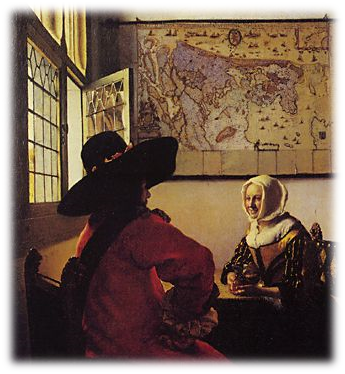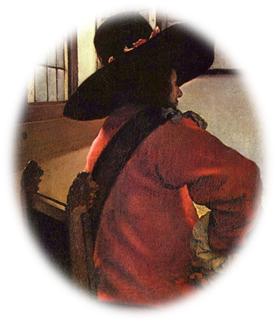 The painting ‘Officer and laughing girl’ was done by Johannes Vermeer between 1655 and 1670. It presents a inside room bathed by the traditional golden light used by Vermeer. The composition portraits an official of the Dutch army with his red uniform and a big black hat in the foreground who is talking with a young woman in the background. Light, that comes from the mid open window, helps to contrast light and darkness creating a clear moment of intimacy in which the officer and the girl are mere objects to create a marvelous sense of light, space and perspective. The rosy woman, holding a glass of wine, is looking to the officer and laughing at some witticism. They are both seated on two chairs that constantly appear in Vermeer’s compositions as well as the map placed on the wall.
The painting ‘Officer and laughing girl’ was done by Johannes Vermeer between 1655 and 1670. It presents a inside room bathed by the traditional golden light used by Vermeer. The composition portraits an official of the Dutch army with his red uniform and a big black hat in the foreground who is talking with a young woman in the background. Light, that comes from the mid open window, helps to contrast light and darkness creating a clear moment of intimacy in which the officer and the girl are mere objects to create a marvelous sense of light, space and perspective. The rosy woman, holding a glass of wine, is looking to the officer and laughing at some witticism. They are both seated on two chairs that constantly appear in Vermeer’s compositions as well as the map placed on the wall.
-
Provenance of the painting:
As seen on the essential Vermeer webpage:
|
• (?) Pieter Claesz van Ruijven, Delft (d. 1674); (?) his widow, Maria de Knuijt, Delft (d. 1681); |
|
• (?) their daughter, Magdalena van Ruijven, Delft (d. 1682); |
|
-
Colour technique:
Vermeer painted ‘Officer and laughing girl’ with a blush loaded with pigments with the technique of ‘pointillé‘ that is applying thick dabs. With the dabs Vermeer is able to distribute sparkling points of light throughout all the canvas. Regarding the use of colours, Vermeer mostly used yellowish and reddish tonalities. The brightness of these tonalities stood out by the use of light that we are going to comment now.
-
Use of light:
Vermeer developed his mastery as a luminist. Maybe, one of the main features of this painting is Vermeer’s use of light. A heavy bright light that bathes the room and causes intense contrasts (As some of the paintings of the Italian artist Caravaggio.) between the light and dark zones. The light comes from the half open window at the left hand side of the painting and reflects itself on the cream-coloured background
|
Type: |
Oil on canvas |
|
Date: |
1655-1670 |
|
Dimensions: |
50.5 x 46 cm |
|
Location: |
Frick Collection, New York. |
that is enhanced even with pink tonalities and above all the woman’s face who is bathed in this light. In contrast, the figure of the officer with a dark hat and red jacket is hardly a silhouette. The light helped Vermeer to create on the one hand, the atmosphere of the room and  perspective on the other.
perspective on the other.
-
The Officer:
As we have mentioned, the officer is turned round so we could barely see his face, moreover he is nor bathed by light as the lady is. The light and his position in the picture help to produce a feeling of uncertainty between the laughing girl and him and also the sense of space and perspective. The observer might feel difficult to decode his thoughts but we know that he is having a good time because the lady is laughing at his face. Critics have argued that the position of his hand indicated emotional withdrawal but this clearly contrast with the girl’s expression. His face is immersed in deep shadow and it does not tell anything from the character.
The colour red of his uniform was used by the Dutch Army in the 17th century. We know that he is an officer because he wears a black sash on his right shoulder. However, the observer in not thrilled by the rank of the officer but by his psychological presence in the painting. Vermeer uses him as a repoussoir that is in two dimension works, it is very common to place a big object in the left/right foreground to direct the viewer’s eye into the composition. Finally, as Arthur Wheelock has stated the vermillion of the jacket ‘may have been chosen for this color’s association with passion and power. Had it been green or beige, the mood on the painting would have been entirely different.’
-
The girl:
As in most of Vermeer’s paintings, the woman of the picture has not been identified. Some critics claimed that she might be Vermeer’s wife. Her face is covered by light contrasting the obscure and austere presence of
 the officer. She wears a yellow garment that Dutch women wore it as a daily wear.
the officer. She wears a yellow garment that Dutch women wore it as a daily wear.  Furthermore, although not seen in many reproductions, she is wearing an olive apron, which was very common in Dutch paintings. One possible explanation for this is that the officer has arrived while she was working in the house. Nonetheless, her expression and body language suggests that this presence is more than welcome.As can be seen in with an X-ray photograph, Vermeer painted the woman with a large cap that covered most of her yellow garment, but Vermeer decided to reduced it and now the cap frames her face and makes us focus on her expression.
Furthermore, although not seen in many reproductions, she is wearing an olive apron, which was very common in Dutch paintings. One possible explanation for this is that the officer has arrived while she was working in the house. Nonetheless, her expression and body language suggests that this presence is more than welcome.As can be seen in with an X-ray photograph, Vermeer painted the woman with a large cap that covered most of her yellow garment, but Vermeer decided to reduced it and now the cap frames her face and makes us focus on her expression.
-
Chairs and map:
 The chair that appears in the painting is known as ‘Spanish chair’ and it also appears even in the same position in other paintings. The chair is characteristic because of the two finials with lion heads and rings through the muzzles. Furthermore, we have to pay attention to the map that hangs at the back. It is a map of Holland and West Frieseland designed by Balthazar Florisz Van Berckenrode in 1620. This same map also appears in ‘The love letter’ and ‘Woman in blue reading a letter’. In the former it appears in brown but in the latter it appears in colour. However, there are no copies of the map so we cannot know which one Vermeer had.
The chair that appears in the painting is known as ‘Spanish chair’ and it also appears even in the same position in other paintings. The chair is characteristic because of the two finials with lion heads and rings through the muzzles. Furthermore, we have to pay attention to the map that hangs at the back. It is a map of Holland and West Frieseland designed by Balthazar Florisz Van Berckenrode in 1620. This same map also appears in ‘The love letter’ and ‘Woman in blue reading a letter’. In the former it appears in brown but in the latter it appears in colour. However, there are no copies of the map so we cannot know which one Vermeer had.
-
Camera Obscura in this painting
According to the BBC History webpage, there is no documentary evidence that Jan Vermeer used the camera obscura in his painting. However it is commonly believed that he did. Nowadays, the only sources of information are his paintings themselves. At the end of the 19th century, the American Joseph Pennell was the first to state that Vermeer might have used this device in paintings such us ‘Officer and laughing girl’. The officer and the girl sit very close in the painting however, the size of the officer’s head is twice as bigger as the size of the lady’s. Even though the perspective is correct in the geometrical sense, the problem is that the viewpoint is taken from the officer. This was then called ‘Photographic perspective.’ As explained in the BBC website, nowadays we are familiar to the fact that in pictures foreground objects appear bigger than those of the background. This is very unusual for Vermeer’s times, his contemporaries would have probably painted the officer and the girl in their actual size.
Another element that suggests that Vermeer might have used this device are the maps that hang on the walls of his paintings like in ‘Officer and laughing girl.’ The maps of the paintings are exact reproductions of the original. Vermeer might have copied them with the help of the camera obscura although he had other alternatives to do the copies so faithfully. All in all, in the book Vermeer and the camera obscura by Steadman, he concludes that Vermeer did use the device although there are still a portion of Vermeer scholars that do not agree.
-
Space and perspective in the painting
 Swillens claims that the same room used in ‘Officer and laughing girl’ is also used in other two paintings: ‘Girl reading a letter by an open window’ and ‘The Milkmaid.’ It is generally believed that Vermeer painted these three paintings between 1657-1660. The setting does not seem to appear again in other works of Vermeer. Thus, it is believed that the room was at Vermeer’s small hotel where he lived in the first ages of her marriage.
Swillens claims that the same room used in ‘Officer and laughing girl’ is also used in other two paintings: ‘Girl reading a letter by an open window’ and ‘The Milkmaid.’ It is generally believed that Vermeer painted these three paintings between 1657-1660. The setting does not seem to appear again in other works of Vermeer. Thus, it is believed that the room was at Vermeer’s small hotel where he lived in the first ages of her marriage.
For more information of space and perspective on ‘Officer and laughing girl’ click here.
http://www.wga.hu/frames-e.html?/html/v/vermeer/02b/08offic.html
http://museodelarte.blogspot.com/2009/10/oficial-y-mujer-sonriendo-officer-and.html
http://www.cossio.net/actividades/pinacoteca/p_05_06/vermeer_intimista.htm
